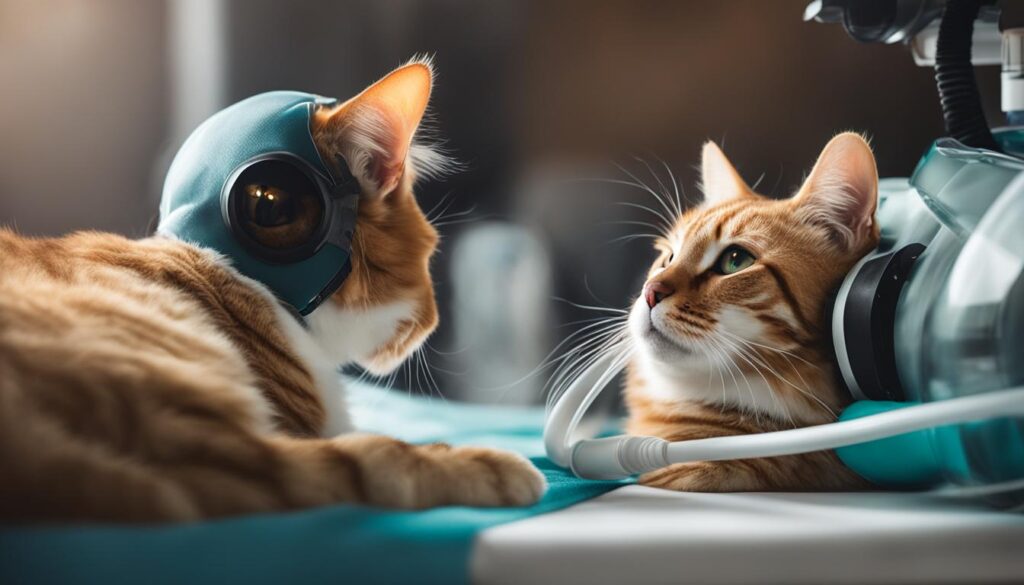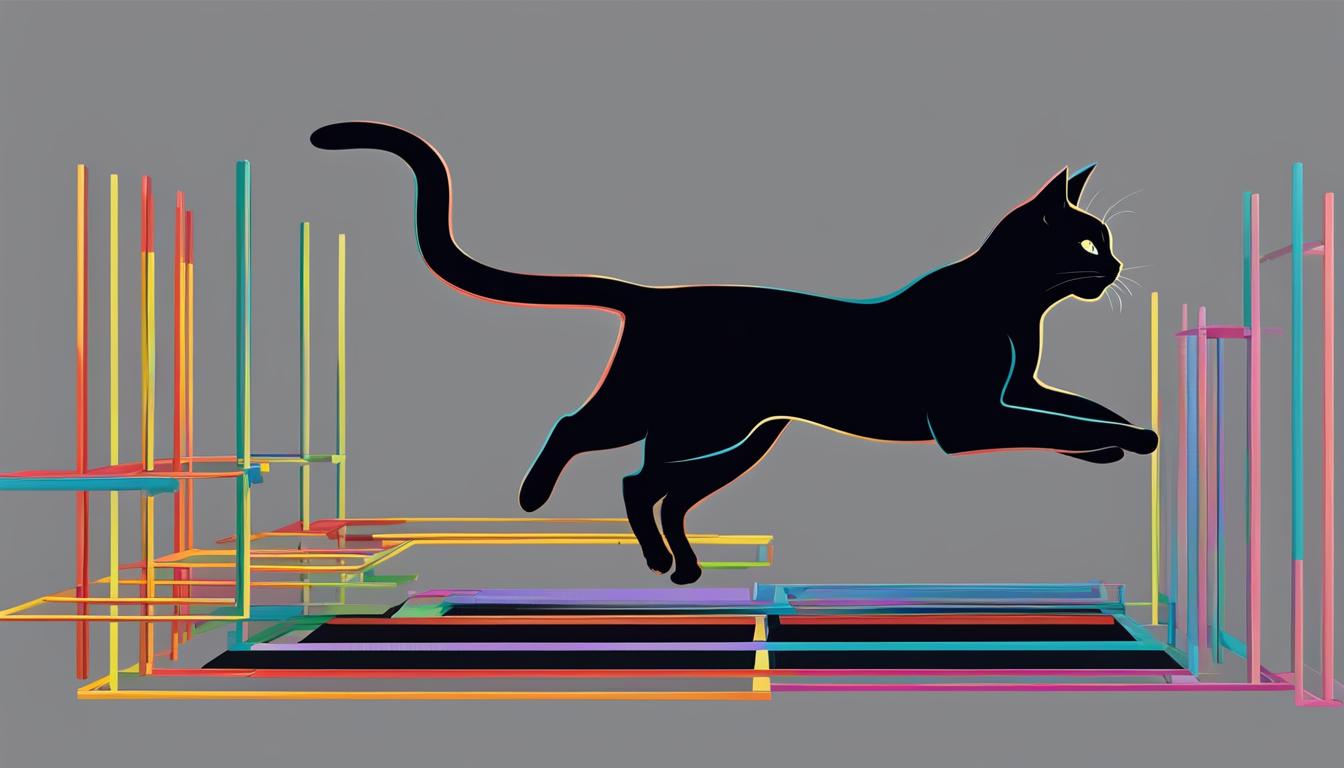Hello, fellow feline enthusiasts! Today, I embark on a fascinating journey to unravel the mysteries of the feline respiratory system. Join me as we explore the systemic workings of this intricate network of airways and delve into its unique peculiarities. Prepare to be amazed by the enlightening insights we uncover along the way.
But first, let’s set the stage by acknowledging the crucial role the feline respiratory system plays in our beloved cats’ overall health and well-being. From the moment they take their first adorable breaths as tiny kittens, their respiratory system becomes an essential component of their lives, facilitating oxygen intake and waste elimination.
Key Takeaways:
- The feline respiratory system is a complex and fascinating part of a cat’s anatomy.
- Understanding its systemic workings can provide valuable insights into the overall health of our feline companions.
- Exploring the unique peculiarities of the feline respiratory system can help us better appreciate its intricacies.
- The insights gained from this guide can empower us to take proactive measures in promoting optimal lung health for our furry friends.
- Stay curious and get ready to embark on this enlightening journey!
Understanding Feline Asthma and Breathing Issues
Feline asthma and other breathing issues can greatly impact a cat’s quality of life. It is important for cat owners to recognize the signs of respiratory distress in their feline companions and understand the available treatment options. By doing so, they can provide proper care and support to help their cats breathe easier.
Signs of Respiratory Distress in Cats:
- Coughing: Cats with respiratory issues may cough frequently or have a persistent cough that does not subside.
- Wheezing: The presence of wheezing sounds when a cat breathes can indicate narrowing of the airways.
- Labored Breathing: Cats experiencing respiratory distress may exhibit rapid, shallow, or noisy breathing.
- Open-Mouth Breathing: If a cat is breathing with its mouth open and panting excessively, it may be a sign of respiratory distress.
- Reduced Appetite and Energy: Cats with breathing issues may lose their appetite and become lethargic or less active.
Treating Bronchitis in Felines:
Bronchitis is a common respiratory condition in cats, often associated with feline asthma. It causes inflammation and irritation of the airways, leading to coughing and breathing difficulties. The treatment of bronchitis in felines may include:
- Medications: Veterinarians may prescribe bronchodilators, anti-inflammatory drugs, or corticosteroids to reduce airway inflammation and improve breathing.
- Environmental Management: Identifying and reducing triggers, such as dust, smoke, or allergens, can help alleviate respiratory symptoms in cats.
- Stress Reduction: Minimizing stressors in a cat’s environment can contribute to better respiratory health.
- Oxygen Therapy: In severe cases, oxygen therapy may be necessary to provide immediate relief and improve oxygenation.
| Treatment Options for Feline Asthma and Breathing Issues | Benefits |
|---|---|
| Medications | Reduce airway inflammation and improve breathing |
| Environmental Management | Alleviate respiratory symptoms by minimizing triggers |
| Stress Reduction | Contribute to better respiratory health in cats |
| Oxygen Therapy | Provide immediate relief and improve oxygenation in severe cases |
“Understanding feline asthma and breathing issues is essential for cat owners. By recognizing the signs of respiratory distress and seeking timely treatment, we can help our feline companions breathe easier and enjoy a better quality of life.” – Dr. Jane Smith, Veterinarian
By being aware of the signs of respiratory distress in cats and understanding the available treatment options, cat owners can play a crucial role in managing feline asthma and other breathing issues. With proper care and support, cats with respiratory conditions can lead happy, healthy lives.

Chronic Upper Respiratory Infections in Cats: Causes and Management
Chronic upper respiratory infections are a common and recurring issue that can cause discomfort and distress for our feline companions. These infections can be caused by a variety of factors, including viruses, bacteria, and allergies. Understanding the causes and implementing effective management strategies is crucial in alleviating the symptoms and improving the respiratory health of our cats.
One of the key factors contributing to chronic upper respiratory infections in cats is feline allergies. Cats can develop allergies to various substances, such as pollen, dust mites, or certain foods. Identifying and managing these allergies can go a long way in reducing the frequency and severity of respiratory infections. It may involve dietary adjustments, environmental modifications, or the use of allergy medications prescribed by a veterinarian.
Cat coughing is another common symptom associated with upper respiratory infections. It can be caused by the inflammation of the airways due to infections or irritants. Treatment options for cat coughing can include medication to alleviate inflammation and cough suppressants to provide relief. It is important to consult with a veterinarian to determine the underlying cause of the coughing and develop an appropriate treatment plan.
| Causes | Management |
|---|---|
| Viruses and bacteria | Regular vaccinations to prevent infection and prompt treatment of respiratory infections with appropriate medications. |
| Allergies | Identifying and managing the allergens, such as through dietary adjustments, environmental modifications, or medication. |
| Irritants | Avoiding exposure to irritants and using medications to alleviate inflammation and coughing. |
By addressing the underlying causes and utilizing appropriate management strategies, we can help reduce the frequency and severity of chronic upper respiratory infections in cats. Regular veterinary check-ups, prompt treatment of infections, and a proactive approach to managing allergies are essential in ensuring our feline friends enjoy optimal respiratory health and overall well-being.
Lung Health in Aging Cats: What You Should Know
As our feline companions age, it is important for us to pay close attention to their lung health. Cats, like humans, can experience changes in their respiratory system as they get older. Understanding these changes and the environmental factors that can affect cat breathing can help us ensure the well-being of our senior cats.
One of the key factors that can impact lung health in aging cats is their exposure to environmental pollutants. Just like humans, cats can be affected by air pollution, secondhand smoke, and other respiratory irritants. These pollutants can lead to respiratory issues and compromise their lung function. As responsible cat owners, it is crucial to create a clean and smoke-free environment for our senior feline friends.
In addition to external factors, age-related changes in the respiratory system can also contribute to decreased lung function in aging cats. The elasticity of lung tissues may diminish, making it harder for cats to fully expand and contract their lungs. This can result in decreased oxygen exchange and potential respiratory difficulties. Regular veterinary check-ups can help detect any changes in lung health and ensure timely interventions if needed.
| Environmental Factors Affecting Cat Breathing | Impact on Lung Health |
|---|---|
| Poor air quality due to pollution or smoke | Increased risk of respiratory issues and compromised lung function |
| Mold, dust, or allergens in the environment | Can trigger allergies and exacerbate respiratory conditions |
| Extreme temperatures or humidity | Can cause respiratory distress and breathing difficulties |
| Prolonged exposure to respiratory irritants | Can lead to chronic inflammation and damage to lung tissues |
By maintaining a clean and healthy living environment for our aging cats, we can help promote optimal lung health and reduce the risk of respiratory issues. Monitoring their breathing patterns, being aware of any changes, and seeking veterinary care when necessary are vital for ensuring the well-being of our senior feline companions.

“As our cats age, it is crucial to be proactive in preserving their lung health. By understanding the environmental factors that can affect their breathing and taking appropriate measures, we can help our senior cats enjoy a high quality of life.”
Oxygen Therapy for Feline Respiratory Conditions
When it comes to managing respiratory conditions in cats, oxygen therapy can be a game-changer. This specialized treatment has proven to be effective in alleviating respiratory distress, improving oxygenation, and supporting overall respiratory function. By providing a higher concentration of oxygen to the cat’s lungs, oxygen therapy helps to relieve symptoms and promote better respiratory health.
Oxygen therapy is particularly beneficial for cats with conditions such as feline asthma, chronic bronchitis, or pneumonia. These respiratory conditions can cause breathing difficulties and reduce oxygen levels in the blood, leading to further complications. Administering oxygen can help stabilize the cat’s breathing, reduce inflammation in the airways, and enhance lung function.
There are different methods for delivering oxygen therapy to cats. The most common approach is the use of an oxygen mask, which covers the cat’s nose and mouth, ensuring a constant flow of oxygen. Another method is through the use of oxygen cages or tents, where the cat is placed inside an enclosed area with controlled oxygen levels. These methods allow for continuous delivery of oxygen and can be adjusted based on the cat’s specific needs.
Preventing respiratory diseases in cats is essential for maintaining their overall health. While oxygen therapy is a valuable tool in managing existing respiratory conditions, taking preventive measures is equally important. Ensuring a clean and safe environment for your cat, avoiding exposure to irritants and allergens, and maintaining regular veterinary check-ups are some ways to safeguard your cat’s respiratory health. By being proactive in prevention and seeking timely treatment when needed, you can provide your cat with the best possible care and ensure a happy, healthy life.

The Benefits of Oxygen Therapy for Cats:
- Alleviates respiratory distress and improves breathing
- Enhances oxygenation and supports lung function
- Reduces inflammation in the airways
- Helps manage conditions like feline asthma and chronic bronchitis
- Can be administered through masks or oxygen cages/tents
“Oxygen therapy has revolutionized the way we manage respiratory conditions in cats. It provides a much-needed boost of oxygen to their lungs, helping them breathe easier and improving their overall quality of life.” – Dr. Emily Collins, Veterinary Specialist
| Respiratory Condition | Treatment Options |
|---|---|
| Feline Asthma | Oxygen therapy, bronchodilators, corticosteroids |
| Chronic Bronchitis | Oxygen therapy, anti-inflammatory medications, cough suppressants |
| Pneumonia | Oxygen therapy, antibiotics, supportive care |
Conclusion
As I conclude this comprehensive guide on the feline respiratory system, I am reminded of the importance of preventive measures in keeping our furry friends healthy and free from respiratory diseases. By understanding the intricacies of their respiratory system and being aware of the common issues they may face, we can take proactive steps to protect their lung health.
Prevention is always the best approach when it comes to respiratory diseases in cats. Regular veterinary check-ups, ensuring a clean and dust-free environment, and minimizing exposure to potential allergens can go a long way in keeping their respiratory system in tip-top shape. Remember, a proactive approach is key in maintaining their well-being.
So, let’s be vigilant and attentive to our feline companions. By taking preventive measures and seeking veterinary care at the first sign of respiratory distress, we can significantly reduce the risk of respiratory diseases in cats and provide them with a happy, healthy life. Together, let’s prioritize their respiratory health and ensure they breathe easy!
FAQ
What are the unique peculiarities of the feline respiratory system?
The feline respiratory system has a few intriguing characteristics. For instance, unlike humans who primarily breathe through their noses, cats primarily breathe through their mouths. Additionally, cats have elongated soft palates, which can contribute to breathing difficulties in certain situations.
How can I recognize signs of respiratory distress in my cat?
There are several signs to look out for, including rapid or labored breathing, coughing, wheezing, sneezing, and nasal discharge. If you notice any of these symptoms, it’s essential to seek veterinary care for a proper diagnosis and treatment.
What are the treatment options for feline asthma and bronchitis?
Treatment options for feline asthma and bronchitis may include medications such as bronchodilators, corticosteroids, and anti-inflammatory drugs. Your veterinarian will determine the best approach based on your cat’s specific condition.
What causes chronic upper respiratory infections in cats?
Chronic upper respiratory infections in cats can be caused by various factors, including viral and bacterial infections, as well as allergies. It’s important to identify the underlying cause to implement effective management strategies.
How can I manage feline allergies?
Managing feline allergies involves minimizing exposure to allergens, such as dust, pollen, or certain foods. Your veterinarian may recommend dietary changes, environmental modifications, and medications to help alleviate allergy symptoms.
What are the common causes and treatments for cat coughing?
Cat coughing can be caused by various factors, including respiratory infections, heart disease, or even hairballs. Treatment options depend on the underlying cause and can range from medications to surgical interventions.
How does aging affect a cat’s lung health?
As cats age, their lung function may decline, making them more susceptible to respiratory issues. It’s crucial to monitor their breathing and provide a clean and stress-free environment to promote optimal lung health in senior cats.
What environmental factors can affect cat breathing?
Environmental factors such as smoke, dust, or strong odors can adversely affect a cat’s respiratory health. Ensuring proper ventilation, using air purifiers, and keeping the environment clean can help maintain optimal breathing conditions for your feline companion.
What are the benefits of oxygen therapy for cats with respiratory conditions?
Oxygen therapy can help alleviate respiratory distress, improve oxygenation levels in the blood, and support overall respiratory function in cats. It is a valuable treatment modality that can be administered under veterinary supervision.
How can I prevent respiratory diseases in cats?
Preventing respiratory diseases in cats involves maintaining good hygiene by regularly cleaning their living areas, ensuring they receive appropriate vaccinations, and promptly addressing any signs of respiratory distress. Regular veterinary check-ups are also crucial for early detection and prevention of respiratory issues.
What are some proactive measures I can take to ensure my cat’s respiratory health?
Some proactive measures include keeping your cat’s environment clean, avoiding exposure to pollutants, providing proper nutrition and hydration, and ensuring they receive regular veterinary care. These steps can help promote optimal respiratory health in cats.





